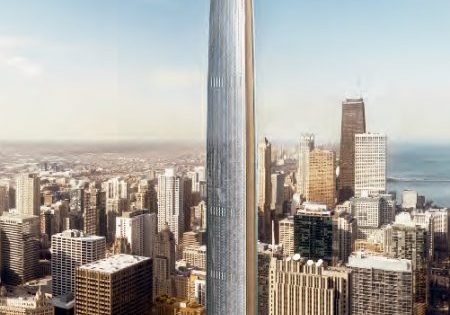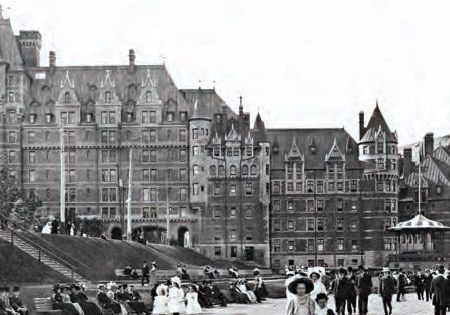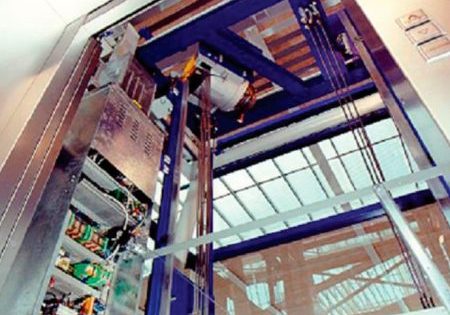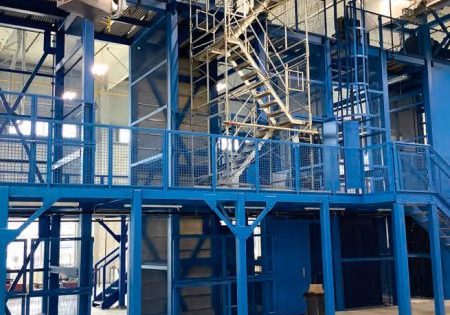Elevator Air-Sanitizing System
Aug 1, 2020

NYC company debuts product that uses air filtration and UV-C light to kill pathogens.
by Nick Gretsuk
CEC Elevator Cab Corp., based in Bronx, New York, has introduced Sterilyft, an elevator air-sanitizing system utilizing high-efficiency air filters and ultraviolet-C (UV-C) irradiation. Sterilyft was recently installed at Vornado Realty Trust’s 57-story Penn 1 office building, built in 1972 and served by 44 passenger and two freight elevators. The system is suitable for retrofitted and new elevators and can be paired with CEC’s Sterilcab cab enclosure that includes all needed ductwork. In developing Sterilyft, CEC considered:
- The safe use of UV-C light in an elevator
- The typically poor air circulation inside elevators
- The volume of air exchange needed to maximize cleaning
- The danger of increasing the time pathogens stay airborne
- Using high-efficiency filters to purify air
- Increasing the length of time pathogens are exposed to UV-C light
- Increasing the strength of the UV-C light to which pathogens are exposed
- Balancing the dynamic pressure of the fan and static pressure of the air filters
A double-filtration system creates a “kill chamber” — an air-moving box that can be mounted on top of any elevator. Air from inside the cab circulates through the box, where UV-C light destroys viruses, bacteria and germs. Using a powerful and controllable turbine fan, Sterilyft continually draws air to the ceiling of the cab and into the filtering and sterilization unit on top of the car. Once the air has been filtered and bombarded by UV-C light, filtered and sanitized air is forced through ducting near the floor and into the elevator, beginning its travel back up to the ceiling in a continual loop.
Overview of Operation
The fan unit draws up to 710 ft3 of air from the interior of the cab. (The typical volume of air in a 8-ft-tall, 3500-lb capacity cab is 290 ft3.) This volume equates to an air exchange of a typical 3500-lb capacity car approximately every 24 s (or twice per min). Air is forced to the roof of the car by negative pressure created by air being drawn into the fan unit/sanitization chamber. When it enters the sanitization chamber, air is forced through the first high efficiency particulate air (HEPA) filter with a minimum efficiency reporting value (MERV) rating of 13.
The novel coronavirus (COVID-19) is found to be similar to previous coronaviruses SARS and MERS and, consequently, would likely be killed by UV-C light as effectively.
MERV ratings measure how effectively a filter stops dust and other contaminants from passing into the air stream. Filters with higher MERV ratings trap small particles more effectively than those with lower MERV ratings. In general, filters with MERV ratings of less than 16 are considered appropriate for residential, commercial and general hospital use.[1] Sterilyft’s filter efficiency is such that all dust, pollen, mold, smoke, smog and cough/sneeze particulates are effectively trapped. As viruses, bacteria and germs are typically smaller than most filters (0.1 to 0.3 microns), any free-floating particles are slowed by the first filter before they flow into the UV-C chamber. All particles and air flowing into and through the chamber will be radiated by powerful 4.5-W, 254-nm UV-C light. As scientific studies have shown, viral and bacterial organisms are rendered inactive from momentary radiation with UV-C light, which breaks the molecular bond of their DNA.
After the air is bombarded and sanitized by UV-C light, the air passes through a secondary, MERV 13 HEPA filter to ensure maximum filtration prior to being sent back into the elevator through rigid ducting at the base of the cab, then traveling from the floor back to the ceiling.
Testing and Research
For UV-C light’s effects on germs and viruses, CEC researched several tests and studies on the use of UV-C light to clean water, air and solid surfaces. On the UV band of light (A, B and C), UV-C is the section of invisible light/radiation measuring 100-380 nm. As the UV-C band does not reach the Earth’s surface from the sun (only UV-A and -B penetrate the atmosphere), its effects on viruses, germs and bacteria are profound and destructive, and do not occur naturally. Testing within the UV-C band found that the maximum molecular destruction of the DNA bond occurred between 200 and 300 nm. Peak killing of germs, bacteria and viruses occurred at 254 nm. Tests showed that H1N1, SARS and MRSA were all successfully killed by UV-C radiation. The novel coronavirus is found to be similar to previous coronaviruses SARS and MERS and, consequently, would likely be killed by UV-C light as effectively.
As studies show, 100% sterilization of air and airborne particles is unachievable outside of a controlled, stabilized and static environment. In addition, such processes as photoreactivation and base excision repair, in which a cell repairs DNA damaged by UV-C light, must be taken into account. With this in mind, CEC designed its system to slow and hold the air and its contents in the UV-C kill chamber for as long as possible. CEC worked to sanitize the air as close as possible to 99%.
As the length of time in UV radiation increases nucleic acid destruction of viral DNA, the disinfection process occurs between the two HEPA filters in the UV-C sanitization “kill chamber.” In the area between the two filters, air and, in turn, airborne particles, are slowed. This decreased movement increases the time of exposure, facilitating maximum destruction of viral or living organisms as they pass through the chamber.
Servicing
The system requires minimal servicing during its life and use. Service may be performed by CEC or the building’s elevator service technician during normal maintenance and consists of:
- Turning off the fan and UV-C light power switches on the service enclosure cover
- Removing the unit’s service cover screws
- Opening the cover and replacing two slide-in HEPA filters, and screwing in a new UV-C bulb
- Replacing HEPA filters every six months and the UV-C lamp every year (or as required)
Safety During Servicing
Exposing human skin and eyes to UV-C light, given its cellular destructive nature, is extremely dangerous. Three features enhance safety when servicing the equipment:
- A light on the service cover illuminates when the UV-C
- Large, prominent “DANGER” labels on the service access cover instruct the technician on proper safety protocols, including instructions to turn the fan and light off prior to opening the cover for servicing. Two rocker-type switches with prominently visible labels are on the cover directly next to all warning labels.
- In case safety provisions 1 and 2 are ignored or missed, a shutoff switch is attached to the interior of the enclosure
that immediately kills power to the fan and UV-C light upon removal of the service access cover.
Proper safety protocols for servicing, replacing and properly disposing of components should be followed. Time and care should be taken to review, prepare for and properly understand the written instructions and personal protective equipment recommendations for Sterilyft.
System Use
The air sanitizing system has been designed for continual use, with the UV-C lamp and fan operational at all times. Fan speeds are adjustable, at 15% (107 ft3/min), 23% (164 ft3/min), 50% (355 ft3/min), 67% (475 ft3/min), 83% (590 ft3/min) or 100% (710 ft3/min). Fan speeds can be controlled by either a hardwired dimmer switch mounted on top of the car or by a wireless remote control unit, which is provided.
The fan unit is attached to a bedplate with rubber dampeners between the unit and bedplate to isolate it from the top of the structure. Fan noise levels range from 38 to 62 dBA, depending on the fan selected and its speed. The fan was designed to facilitate maximum volume air movement at minimum noise levels.
Though the UV-C lamp is designed to emit no ozone during its operation, a slight odor may be emitted when air passes through the system. Observers have compared it to the scent of a hospital or medical office with similar sanitization equipment.
Reference
[1] “What is MERV Rating? Air Filter Rating Chart,” Grainger KnowHow,
February 11, 2020.
Get more of Elevator World. Sign up for our free e-newsletter.







